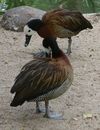Genus Dendrocygna

West indian whistling-duck - The West Indian Whistling Duck is widely scattered throughout the West Indies including a large breeding population in the Bahamas, and smaller numbers in Cuba, the Cayman Islands, Antigua and Barbuda, and Jamaica. It is largely sedentary, apart from local movements which can be 100 km or more. Nests have been reported in tree cavities, on branches, in clumps of bromeliads, and on the ground under thatch palms and other dense bushes. The usual clutch size is 10-16 eggs. It habitually perches in trees, which gives rise to its specific name.
Wandering Whistling Duck - Formerly named Tree Ducks, the Wandering Whistling Duck have their new name because of their loud whistling calls and the whistling noise their wings make during flight.
Black-bellied Whistling-Duck - The Black-bellied Whistling-duck , formerly also called Black-bellied Tree Duck, is a whistling-duck that breeds from the southernmost United States and tropical Central to south-central South America. In the USA, it can be found year-round in parts of southeast Texas, and seasonally in southeast Arizona, and Louisiana's Gulf Coast. It is a rare breeder in such disparate locations as Florida, Arkansas, Georgia and South Carolina.
Fulvous Whistling Duck - The Fulvous Whistling Duck is a common but wary species. It is largely resident, apart from local movements, but vagrancy has occurred to southern Europe. It nests on a stick platform in reeds, laying 8-12 eggs, but hollow trees or old bird nests are occasionally used for nesting.
Plumed Whistling Duck - Described by English naturalist Thomas Campbell Eyton in 1838, its specific epithet honours its namer. Its generic name is derived from the Ancient Greek terms dendron "tree", and kuknos "swan". Alternate common names include; Eyton's Plumed, Red-legged or Whistling Tree-duck, and Grey or Red-legged Whistler
Spotted Whistling Duck - This duck is known for its ability to swim underwater for long periods of time.
Lesser Whistling Duck - This is a largely resident species distributed unevenly from the Pakistan lower river valleys eastwards across most of peninsular India, Nepal terai, Sri Lanka, Bangladesh, Burma, Thailand, Malaysia, Singapore, Indonesia, south China, to Vietnam. It is largely resident, apart from local movements , but Chinese birds winter further south.
White-faced Whistling Duck - This species is gregarious, and at favoured sites, the flocks of a thousand or more birds arriving at dawn are an impressive sight. As the name implies, these are noisy birds with a clear three-note whistling call.








